“There was no greater absurdity than the belief that the enormous amount of pain in the world served no purpose. Unless one accepted that suffering was the direct and immediate object of life, existence was futile. In any case, the longer one lived the more clearly one realized that life was a cheat, a disappointment.”–Dr. Wheeler
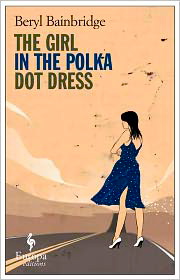 When she died in July, 2010, Beryl Bainbridge, Dame Commander of the British Empire, had been working for the preceding six months on this novel, The Girl in the Polka Dot Dress. Nearly completed at the time of her death, this novel is her twentieth, including five which were nominated for the Booker Prize and two (Injury Time in 1977 and Every Man for Himself in 1996) which won Whitbread Awards. Her 1998 novel Master Georgie was singled out for a posthumous Booker Prize in 2011. Despite the literary honors, Bainbridge has always remained a remarkably accessible author with a mordant wit, a sense of the absurdity of life, a darkly comic approach to her offbeat characters, and an undercurrent of violence which springs to life in unexpected ways. Set in June, 1968, this novel, like many of her other novels, places fictional characters within the fraught circumstances of real historical events, in this case the lead-up to the death of Robert F. Kennedy, and watches them as they twist, trying to adapt to the often bizarre circumstances of their lives.
When she died in July, 2010, Beryl Bainbridge, Dame Commander of the British Empire, had been working for the preceding six months on this novel, The Girl in the Polka Dot Dress. Nearly completed at the time of her death, this novel is her twentieth, including five which were nominated for the Booker Prize and two (Injury Time in 1977 and Every Man for Himself in 1996) which won Whitbread Awards. Her 1998 novel Master Georgie was singled out for a posthumous Booker Prize in 2011. Despite the literary honors, Bainbridge has always remained a remarkably accessible author with a mordant wit, a sense of the absurdity of life, a darkly comic approach to her offbeat characters, and an undercurrent of violence which springs to life in unexpected ways. Set in June, 1968, this novel, like many of her other novels, places fictional characters within the fraught circumstances of real historical events, in this case the lead-up to the death of Robert F. Kennedy, and watches them as they twist, trying to adapt to the often bizarre circumstances of their lives.
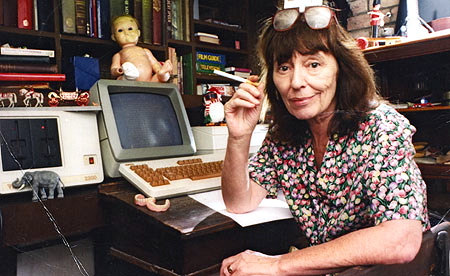
The novel opens with Harold Grasse, known as “Washington Harold,” greeting Rose, whom he regards as “Wheeler’s woman,” at the airport in Baltimore. Rose has come to the United States from Scotland to try to reconnect with a “Dr. Wheeler,” who played an important role in helping her to deal with her miserable childhood, and he has paid for her trip. The mysterious Dr. Wheeler is working on the campaign of Robert F. Kennedy for President, and he is traveling the country, so Harold Grasse volunteers to help her find Wheeler, and the take a camper across the country. Unbeknownst to Rose or some of the other characters, all of whom also seem to know Wheeler, Harold also has his own reasons for wanting to find Wheeler.
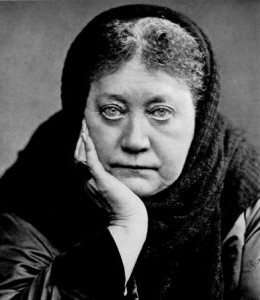
Madame Helena Blavatsky, co-founder of the Theosophist Movement. Rose attended a seance led by one of her followers.
With the point of view alternating between Rose and Harold, who have nothing in common except their interest in Wheeler, the author shows their complete lack of connection on all levels. Rose is “slack,” a young woman who does not bathe or wash her hair often enough to suit the fastidious Harold, a woman who has little education and even less intellectual curiosity, and who is dependent on Harold for her financial needs, believing that Dr. Wheeler will pay him back when they connect. As a young Scottish woman, she also has no understanding of American culture or the parts of the country through with they travel, sometimes making racially insensitive remarks, showing little understanding of the political scene (including the Vietnam War, the murder of Dr. Martin Luther King, and the death of John F. Kenndy), and revealing total incomprehension of the US culture. Starting on the East Coast, the two travel the country to the West Coast to try to catch up with Dr. Wheeler, who is initally in Seattle, then in different cities throughout California, where he is ultimately expected to be at the Ambassador Hotel in Los Angeles for an important speech by Robert F. Kennedy. Along the way, Rose and Harold begin to learn a bit about each other.
The reader, too, learns about Rose through her internal monologues which often run parallel to important conversations by other characters, her subject matter decidedly personal and often involving examples of her abuse by her family, while the other characters are discussing major events, such as insights into the death of Martin Luther King and the Vietnam War. She never really “connects.”
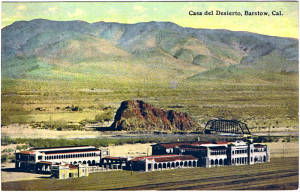
The Casa del Desierto in Barstow, CA, was a derelict rail station when Rose visited. It has since been restored.
For years Rose has searched for explanations for the accidents of history through a variety of religious experiences, hoping for full answers which require little thought on her part. Originally a Protestant, she became a Catholic convert as a teenager, then gave that up because, like other religions, it did not provide justifications for all the tragedies of the world. She and Harold meet a rural monsignor on his way to the funeral of a soldier killed in Vietnam, befriend a lawyer who has just had a mystical experience in which he faced the Judgment Seat, attend a séance with a woman who is a theosophist on her way to England to the home of Madame Blavatsky, meet a woman who is on LSD. Near Santa Ana, Rose meets a woman who has found her “calling” in nature: “[Their hostess] cooked them lunch, the ingredients home-grown, even the chicken. The birds, she trumpeted, were her pride and joy, each one with a name and fondled from birth. She never allowed anyone but herself to wring their necks. ‘It wouldn’t be right,’ she assured Rose. ‘They need somebody they can [expletive] trust!’ The one they were about to devour was called Nessie.”
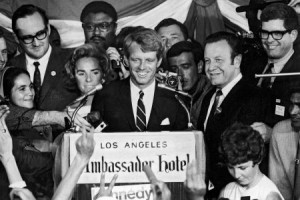 Sudden death and violence among the people Rose, Harold, and their acquaintances meet is common. Several characters have near death experiences, and a couple of bodies materialize during their trip. Filled with darkness, the novel is still strangely humorous, and the balance that Bainbridge strikes between serious philosophical ideas and the just plain weird makes the book great fun to read. The characters are constant sources of surprise, and though the ending does not feel quite finished and the thematic development is still a bit loose, the book is an absolutely wonderful finale to Bainbridge’s distinguished writing career.
Sudden death and violence among the people Rose, Harold, and their acquaintances meet is common. Several characters have near death experiences, and a couple of bodies materialize during their trip. Filled with darkness, the novel is still strangely humorous, and the balance that Bainbridge strikes between serious philosophical ideas and the just plain weird makes the book great fun to read. The characters are constant sources of surprise, and though the ending does not feel quite finished and the thematic development is still a bit loose, the book is an absolutely wonderful finale to Bainbridge’s distinguished writing career.
Also by Bainbridge: EVERY MAN FOR HIMSELF
Photos, in order: The author’s photo is from http://www.mirror.co.uk
Madame Helena Blavatsky was co-founder of the Theosophist Movement in 1875, and Rose attends a seance led by one of her followers. Blavatsky’s photo appears here: http://da.wikipedia.org (I think those eyes would have had me believing anything!)
The Casa del Desierto in Barstow, CA, was a derelict rail station when Harold Grasse insisted that Rose visit it with him in 1968. In 1999, it was restored and reopened as the home of the Western America Rail Museum. http://en.wikipedia.org
The photo of Robert F. Kennedy and his wife Ethel at the Ambassador Hotel is from http://www.scpr.org/
